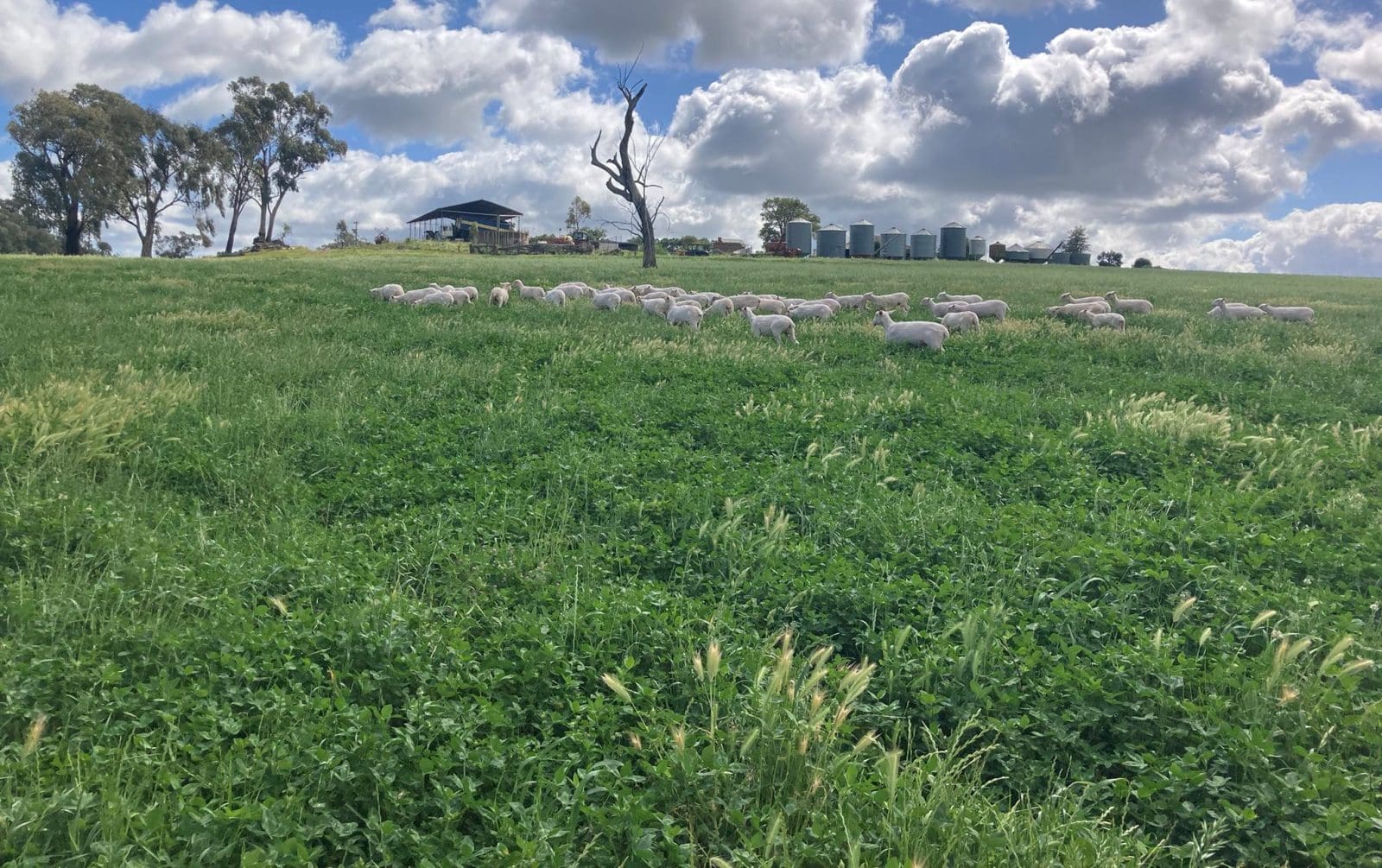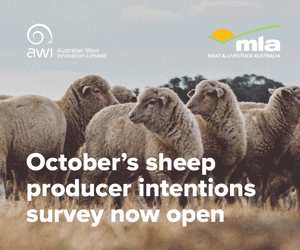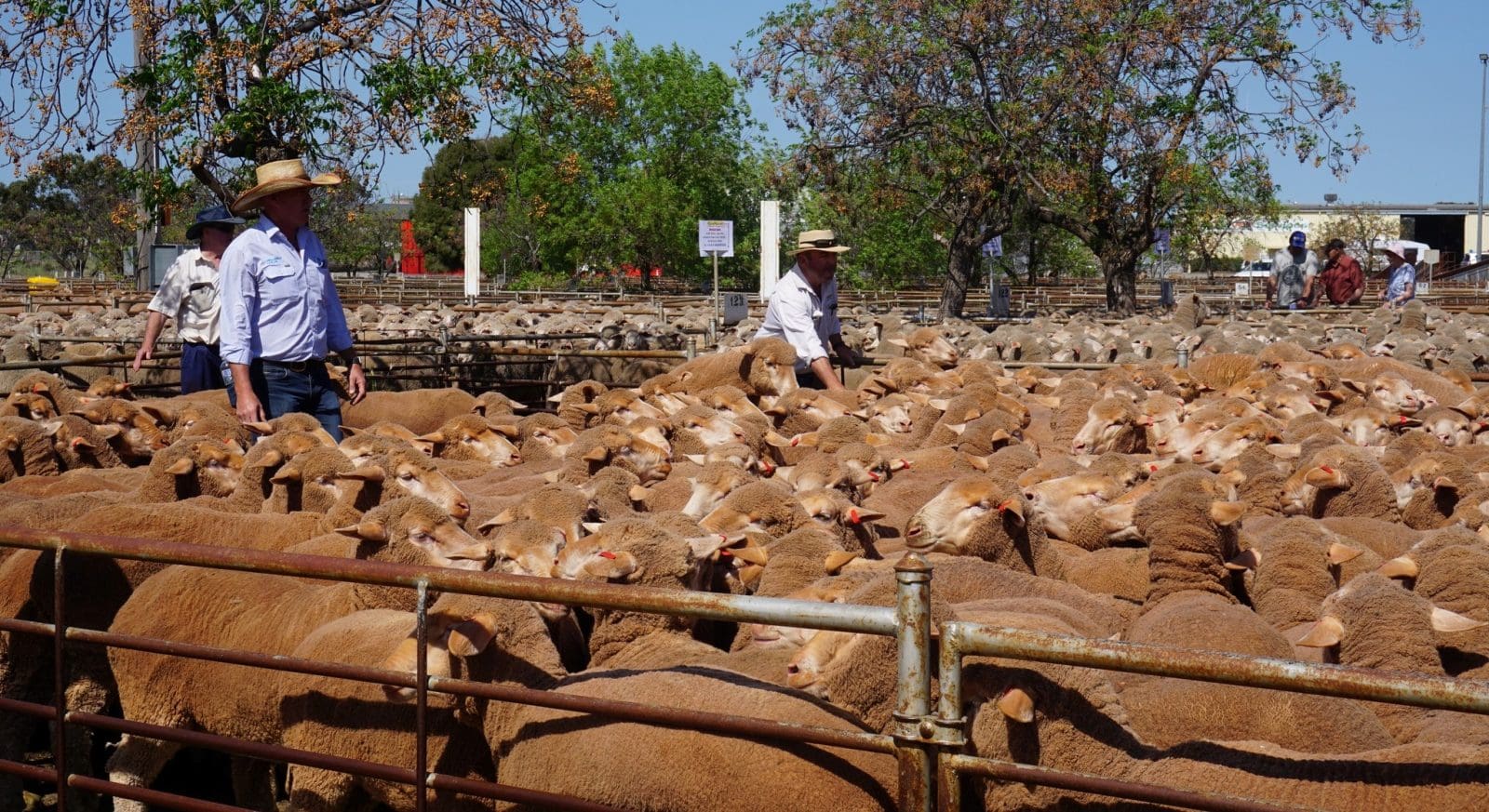
Crossbred lambs at Canowindra in the Upper Lachlan Valley last week on ample paddock feed as is available in many NSW locations off the plains. Photo: Lawrence Balcomb
FARMS across south-eastern Australia lucky enough to get significant rainfall last week have found some breathing space to allow them to retain Merino sheep and lambs over Summer, or even buy in some trade stock at current discount prices.
While the rain missed some districts altogether, it delivered 20-50mm to others.
It has underpinned yield potential on crops, and saved some cereals and canola from being cut for hay, as well as sparking pasture growth to complement what for most is an ample body of dry feed.
This will bookend some weeks on stubble for sheep and lambs after the headers leave the paddock in what is shaping up to be a fast and early harvest.
Store Merino lambs are currently selling for around $70/head, and some producers have been buying or holding lots in anticipation of making $120-$130/head after finishing them in the paddock.
Prices have already bounced this month as processors work through a glut of sheep and lambs brought about by a return to dry conditions, a retreat to normal stocking rates, and concerns about El Niño.
Store demand from east, south
In the West Wyalong district of New South Wales, Quade Moncrieff Livestock & Property director Paul Quade said the district sell-off of surplus stock ended before last week’s rain, that delivered around 25mm to most farms.
“It was very needed; it will help finish crops on the eastern side of town,” Mr Quade said.
“On the western side of town on the red country, it was a little bit late, but crops will still benefit.”
He said prospects for cropping and grazing deteriorate north of the Mid Western Highway on the outer slopes.
 “North of the Lachlan (River) it gets pretty tough; a lot won’t worry about stripping this year.”
“North of the Lachlan (River) it gets pretty tough; a lot won’t worry about stripping this year.”
Closer to West Wyalong, Mr Quade said producers were getting back into equilibrium after a sodden 2022.
That means restocking hay sheds, and getting down to core sheep numbers.
“I think all those older sheep from those couple of wet years are pretty well out of the system.”
Sheep and lamb prices have improved in the past week or two and Mr Quade said prices have drifted up not because of the rain, but in response to the drop in supply of older ewes and wether hoggets.
“People hung on to lambs to grow them out; they didn’t so well in the wet conditions, and they ran them out into hoggets on paddock feed.”

This pen of 180 maiden Merino ewes, account Jack and Leah Jones of Yalgogrin, topped the sale on September 20 at West Wyalong by selling for $160/head to repeat buyers in the Bectric district west of Temora. Photo: Quade Moncrieff Livestock & Property
Mr Quade said mixed farmers have just finished cutting and baling hay, mostly ahead of last week’s rain, after a sodden spring wiped out the 2022 haymaking season.
He said growers were keen to restock with hay as their go-to feed reserve, and surplus young sheep were selling to restockers and traders east and south of West Wyalong.
“Lambs are still very buyable; that market’s starting to pick up a bit.”
Mr Quade said wether lambs were currently trading at $30-$40/head, up from $20-$35 last month.
“That’s still good buying for a weaned lamb at around 30kg liveweight.”
He said buying interest was coming from as far afield as Victoria, and from repeat buyers in the Cowra, Bathurst and Goulburn districts.
Drier in north
At Tullamore on the outer slopes of Central NSW, Mark Mortimer said last week’s rain was very patchy, and the sell-off of stock will continue.
“It’s pretty dry in this part of the world,” Mr Mortimer said.
“People lamb in Winter, and once they wean, they have to start making decisions.”
He said some supplementary feeding of sheep was occurring to put condition on stock destined for sale before summer.
“People are feeding sheep; otherwise, they would have skinny ewes and an unsaleable product.”
In August last year, Mr Mortimer sold wether lambs for $180/head, double the $91/head achieved in August this year.
He said the incentive to grain-finish older ewes and get $120/head or thereabouts last year has well and truly disappeared, and old sheep were flat out paying their way to the works.
However, the recent bounce in mutton prices means that producers appear unlikely to have to consider shooting sheep as their only cost-effective option.
With grain and hay prices remaining high, growers in dry areas are unlikely to feedlot trade sheep, and some are finishing stock on failing crops.
Starting to dry out a bit.
Lactating ewes need 20% fibre in their diet. (The lambs think this is alright as well) pic.twitter.com/wYRRv31gBl
— Mark Mortimer (@sheepGeekCP) October 2, 2023
Mr Mortimer said their heavier country will produce enough wheat to at least cover costs if a yield of two tonnes per hectare is achieved, and canola that was able to access subsoil moisture will be the other cash crop.
On lighter country, Mr Mortimer said “the right call” was made by not planting canola, and 200ha of dual-purpose barley has been grazed out because it had no hope of a worthwhile yield at harvest.
“Those crops are buggered; the sheep have eaten them off.”
Flooding impacted most of NSW’s cropping and mixed-farming districts last year, and while the Mortimers lost their lucerne stand as a result, other pasture remains.
“There’s still plenty of dry feed.”
Mr Mortimer has also been feeding low test-weight barley carried over from the 2022-23 harvest to his sheep.
Not everyone in the major sheep-producing areas of NSW, which extend from north-central NSW to the Victorian and South Australian borders, has the option of home-grown grain to feed.
“Everybody’s been trying to sell at the same time, and we hear the abattoirs are running at 20pc above their kill rate to get through them all.
“We’re talking about a just-in-time product; the supply chain is finely tuned, and that supply coming in has flooded the market.
“We knew we were building the flock for years…and we’ve got a bottleneck in the abattoirs.”
Stubble gets close in SA
Elders northern South Australia livestock manager Damien Webb said mixed farmers generally had the option of holding back stock from the market’s bottom created by a short-term oversupply of lamb and mutton.
“A lot of areas in eastern states have had three or four seasons of flock rebuilding, and older ewes have been kept while prices have been good,” Mr Webb said.
“People are moving those older ewes out now; if they’re fortunate enough to have feed and water, they will hold them over this next period in the hope that prices come up.”
SA’s grain harvest is under way, and Mr Webb said stubble is also a place to finish lambs.
“At $120-$130 for a lamb, it’s still pretty good money.”
Mr Webb said one impact of SA’s very wet 2022 was lambs growing slowly because of worm burdens, even in traditionally lower-rainfall areas including pastoral zones, and they have hit the market recently as hoggets.
“We’ve had barber’s pole in places never known to have worms before, and those lambs were still struggling when they cut their teeth.
“Their growth wasn’t that good, and that’s one reason people haven’t been feeding them grain.”
The other is that grain prices have continued high since harvest, and growers have not had to look for an on-farm value-adding option.
“Grain feeding has fallen away, and there have been a lot of underdone lambs around.”
Mr Webb said SA producers have been aiming to get lambs which will dress out at 24-26kg to market ahead of the late spring flush of lambs out of the South East.
“Most of our clients have moved lambs at $5/kg, but now that stubble’s coming up as a place to put sheep, they’ll be running them through into Summer on that.”
Mr Webb said others were seeing an opportunity to buy in store lambs, particularly if they have grain on hand to feed out.
“If you’re going to buy grain to make a ration that costs around $400/t, that’s the hard one.”
The ballpark figure for an eight-week feeding regime is around 10kg per week, so around $4 per head per week plus water and labour costs.
“People want forward pricing for lambs if they’re investing that kind of money in finishing them.
“That’s not easy at the moment.”
South Australia has also borne the brunt of the Western Australian sell-off sparked by its tough season throughout much of the wheatbelt, and the Winter moratorium on live exports for animal welfare reasons.
“There were sheep coming over from WA some months ago, but it costs $25/head to truck them here, and now the price of sheep in SA and sheep from the west are similar.”

HAVE YOUR SAY